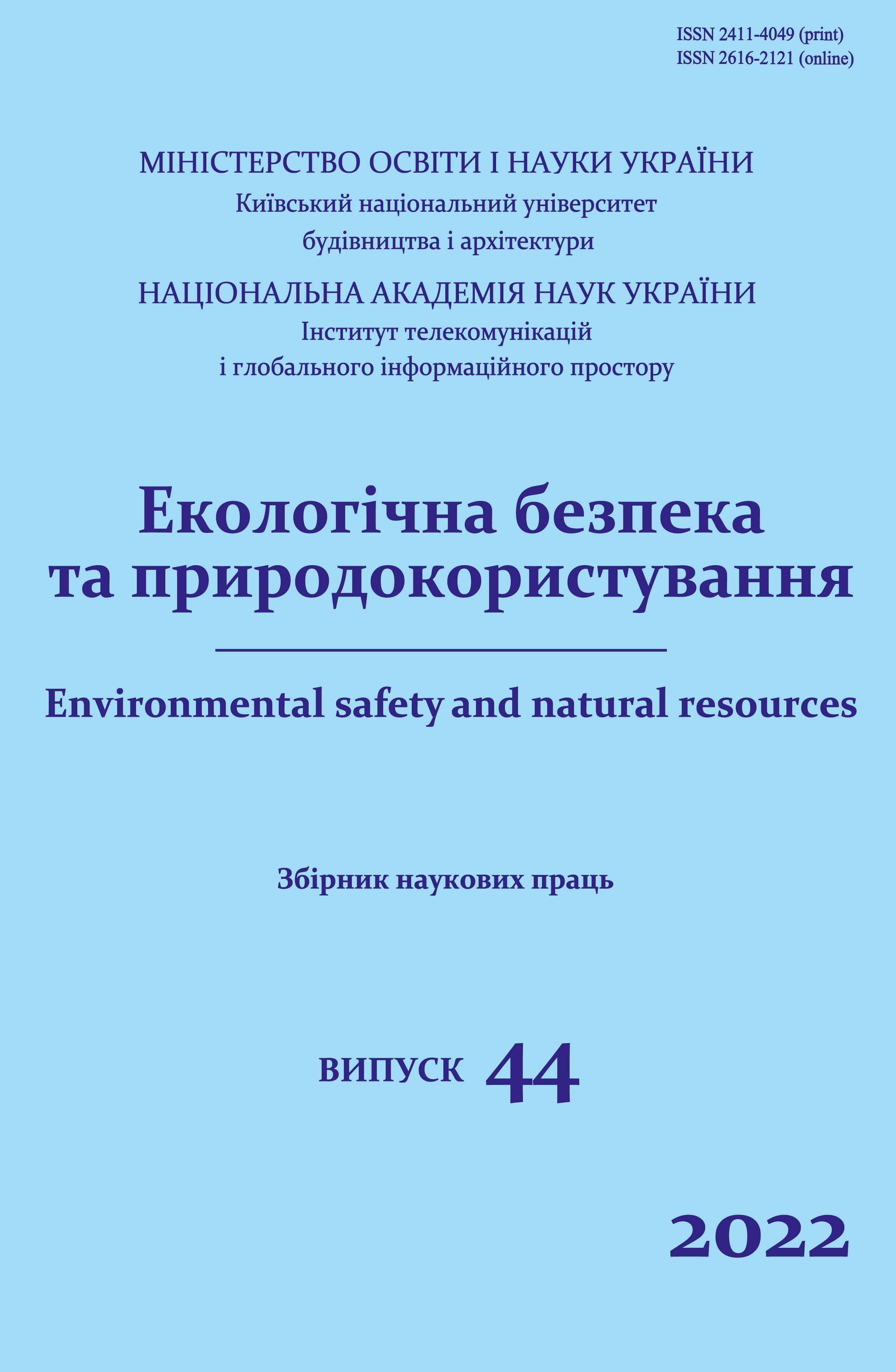Analysis of concentrations of biogenic compounds discharged into water bodies with municipal wastewater
DOI:
https://doi.org/10.32347/2411-4049.2022.4.15-29Keywords:
contamination, biogenic elements, eutrophication, water supply, water qualityAbstract
There were analyzed the effect of increased concentration of biogenic elements, as well as increased temperature on the frequency and magnitude of cyanobacteria reproduction. The goal was to identify the main causes of poor water quality in surface water bodies of Ukraine compared to European countries, as well as the impact of municipal wastewater entering water bodies on the quality of water in them. It is shown that pollution with biogenic elements (compounds of nitrogen and phosphorus) is one of the main reasons for unsatisfactory water quality in water bodies. This, in turn, is the cause of a number of such problems as the change in biological diversity and productivity of water bodies due to the eutrophication of freshwater and marine ecosystems, and the spread of diseases associated with unsatisfactory drinking water quality. One of the main sources of biogenic elements entering surface water bodies is municipal wastewater. Long-term observations of the composition of wastewater from municipal sewage systems indicate that the concentration of biogenic elements in them can be different. It largely depends on the sources of the effluents. In the total amount of nitrogen and phosphorus compounds entering the wastewater, a significant place is occupied by the economic activity of the inhabitants of the residential areas. Experience shows that, regardless of the level of water supply, the total mass of biogens entering the sewage systems from one inhabitant over a certain period of time is constant. However, taking into account the fact that the water availability for residents is different, the concentration of biogens in wastewater will also be different due to different dilutions. The calculation shows that for the entire possible range of water consumption levels (from 100 to 285 l/day per inhabitant according to the standards), the concentration of biogenic elements in wastewater can be: total nitrogen – from 38.6 to 110 mg/l; ammonium nitrogen – from 36.1 to 102.8 mg/l; nitrites – from 2.35 to 6.74 mg/l; nitrates – from 43.27 to 123.67 mg/l; total phosphorus – from 6.31 to 18 mg/l; phosphates – from 15.49 to 44.17 mg/l; organic phosphorus – from 1.26 to 3.60 mg/l.
References
Peiyue, Li, Karunanidhi, D., Subramani, T., & Srinivasamoorthy K. (2021). Sources and Consequences of Groundwater Contamination. Archives of Environmental Contamination and Toxicology, 80, 1-10. https://doi.org/10.1007/s00244-020-00805-z.
Pavliukh, L., Shamanskyi, S., Boichenko, S. and Jaworski, A. (2020). Evaluation of the potential of commercial use of microalgae in the world and in Ukraine. Aircraft Engineering and Aerospace Technology, 93(3), 429-436. https://doi.org/10.1108/AEAT-08-2020-0181.
Jing Dong, Qichao Zhou, Yunni Gao, Qianhong Gu, Genbao Li & Lirong Song (2018). Long-term effects of temperature and nutrient concentrations on the phytoplankton biomass in three lakes with differing trophic statuses on the Yungui Plateau, China. Issue Ann. Limnol. Int. J. Lim., 54, 9. https://doi.org/10.1051/limn/2017031.
Shamanskyi, S., Boichenko, S., & Pavliukh, L. (2021). Estimated Efficiency of Biogenic Elements Removal from Waste Water in the Ideal Displacement Photobioreactor. In: Zaporozhets A., Artemchuk V. (eds) Systems, Decision and Control in Energy II. Studies in Systems, Decision and Control, (Vol. 346. pp. 347-361). Springer, Cham. https://doi.org/10.1007/978-3-030-69189-9_21.
Nezbrytska, I., Shamanskyi, S., Pavliukh, L., & Kharchenko, G. (2022). Assessment of inorganic nitrogen and phosphorus compounds removal efficiency from different types of wastewater using microalgae cultures. Oceanological and Hydrobiological Studies, 51(1), 45-52. https://doi.org/10.26881/oahs-2022.1.05.
Savic, R., Stajic, M., Blagojevi´c, B., & Bezdan, A. (2022). Nitrogen and Phosphorus Concentrations and Their Ratios as Indicators of Water Quality and Eutrophication of the Hydro-System Danube–Tisza–Danube. Agriculture, 12, 935. https://doi.org/10.3390/agriculture12070935.
Osadcha, N.M., Osadchyi, V.I., Osipov, V.V., Biletska, S.V., Kovalchuk, L.A., & Artemenko, V.A. (2020). Methodology of selecting zones vulnerable to surface and groundwater pollution by nitrate compounds. Ukr. geogr. z, 4(112), 38-48. https://doi.org/10.15407/ugz2020.04.038.
Types of water pollution and their consequences. Retrieved 29.09.2021 from: https://www.akvantis.com.ua/stati-i-obzory/tipy-zagryazneniya-vody-i-ih-posledstviya.
Clean water. Retrieved 04.11.2021 from: https://texty.org.ua/water.
Gli´nska-Lewczuk, K., Goła´s, I., Koc, J., Gotkowska-Płachta, A., Harnisz, M., & Rochwerger, A. (2016). The Impact of Urban Areas on the Water Quality Gradient along a Lowland River. Environ. Monit. Assess., 188, 624. https://doi.org/10.1007/s10661-016-5638-z.
Khatri, N., & Tyagi, S. (2015). Influences of Natural and Anthropogenic Factors on Surface and Groundwater Quality in Rural and Urban Areas. Front. Life Sci., 8, 23-39. https://doi.org/10.1080/21553769.2014.933716.
Horbachova, O., & Pavliukh, L. (2022). Modern technologies of organic waste management. Modern science innovations and prospects. In Proceedings of the 10th International scientific and practical conference (pp. 24-30). SSPG Publish. Stockholm, Sweden.
The most valuable resource of the XXI century. HB found out why the quality of drinking water in Ukraine is much worse than in European countries. Retrieved 01.12.2021 from: https://nv.ua/ukr/amp/pitna-voda-v-ukrajini-znachno-girsha-nizh-u-yevropi-chomu-tak-vidbuvayetsya-50201225.html.
Clean water. Retrieved 04.11.2021 from: https://texty.org.ua/water.
Capodaglio, A.G., & Olsson, G. (2020). Energy issues in sustainable urban wastewater management: use, demand reduction and recovery in the urban water cycle. Sustainability, 12, 266.
DBN V.2.5-75:2013. Kanalizatsiya. Zovnishni merezhi ta sporudy. Osnovni polozhennya proyektuvannya. (2013). Minrehion Ukrayiny. Kyiv.
DBN V.2.5-74:2013. Vodopostachannya. Osnovni polozhennya proyektuvannya. (2013). Minrehion Ukrayiny. Kyiv.
Zhukova, V.S., & Sabliy, L.A. (2012). Results of experimental studies of wastewater treatment technology from nitrogen compounds using immobilized microorganisms. Water and water treatment technologies. Scientific and technical news, 3, 25-31.
Shevchenko, T.O. (2016). Study of the impact of biogenic substances in urban wastewater discharged on surface water bodies. Problems of water supply, drainage and hydraulics, 27, 437-445.
Kabakov, A.B., & Shulgai, O.M. (2017). Alimentary water-nitrate methemoglobinemia in children of Ternopil region. Child health, 12(2), 256-259.
Downloads
Published
How to Cite
Issue
Section
License
Copyright (c) 2022 S. Shamanskyi, L. Pavliukh, O. Horbachova, V. Repeta

This work is licensed under a Creative Commons Attribution 4.0 International License.
The journal «Environmental safety and natural resources» works under Creative Commons Attribution 4.0 International (CC BY 4.0).
The licensing policy is compatible with the overwhelming majority of open access and archiving policies.

